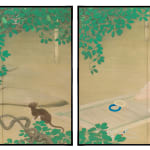Arii Shōun 有井祥雲
An Afternoon Nap , 1920s
Pair of two-panel folding screens; ink, mineral pigments, shell powder and gold on paper
Size each screen 71½ x 71½ in. (181.5 x 181.5 cm)
T-4657
Further images
-
(View a larger image of thumbnail 1
)

-
(View a larger image of thumbnail 2
)

-
(View a larger image of thumbnail 3
)

-
(View a larger image of thumbnail 4
)

-
(View a larger image of thumbnail 5
)

-
(View a larger image of thumbnail 6
)

-
(View a larger image of thumbnail 7
)

-
(View a larger image of thumbnail 8
)

-
(View a larger image of thumbnail 9
)

-
(View a larger image of thumbnail 10
)

-
(View a larger image of thumbnail 11
)

-
(View a larger image of thumbnail 12
)

-
(View a larger image of thumbnail 13
)

-
(View a larger image of thumbnail 14
)

-
(View a larger image of thumbnail 15
)

-
(View a larger image of thumbnail 16
)

-
(View a larger image of thumbnail 17
)

-
(View a larger image of thumbnail 18
)

-
(View a larger image of thumbnail 19
)

-
(View a larger image of thumbnail 20
)

-
(View a larger image of thumbnail 21
)

-
(View a larger image of thumbnail 22
)

Signed and sealed at lower right of the right-hand screen Shōun. On a hot summer day, a small child dozes off seated on a straw mat that has been laid...
Signed and sealed at lower right of the right-hand screen Shōun.
On a hot summer day, a small child dozes off seated on a straw mat that has been laid out for his afternoon playtime next to the tobi-ishi (stepping stones) of an elegant traditional-style garden. A toy (or possibly a pet) bird cradled on his lap, he sleeps with a look of almost Buddha-like tranquility, his toys scattered around him: various musical instruments, a skipping rope, and a large model steam engine. On the left-hand screen, the family cat appears to look up mischievously at another toy caught behind the fleshy, dark green leaves of a climbing shrub, supported on bamboo poles, that provides much needed shade from the shimmering summer heat, here skillfully evoked by a gold wash that permeates the central section of the four panels.
The meticulous, carefully observed painting is a portrait rather than a generalized depiction of early childhood. The practice of family portraiture, most often featuring the daughters of wealthy patrons, was made popular at the start of the Showa era by Nakamura Daizaburō (1898-1947), as was the idea of showing them alongside high-class props such as pampered pets or, as here, expensive toys, some of them perhaps imports from Europe or America.
Born in Hyogo Prefecture, Arii Shōun was a graduate of the municipal art school system in nearby Kyoto. Apprenticed to Takeuchi Seihō, the most forward-looking and influential Kyoto painter of the day, starting in 1910 Shōun was soon showing his work at the Bunten national exhibition in Tokyo. His third appearance at the Bunten was in 1916 and records indicate that he was still active in the mid-1920s, when this screen was likely painted.
On a hot summer day, a small child dozes off seated on a straw mat that has been laid out for his afternoon playtime next to the tobi-ishi (stepping stones) of an elegant traditional-style garden. A toy (or possibly a pet) bird cradled on his lap, he sleeps with a look of almost Buddha-like tranquility, his toys scattered around him: various musical instruments, a skipping rope, and a large model steam engine. On the left-hand screen, the family cat appears to look up mischievously at another toy caught behind the fleshy, dark green leaves of a climbing shrub, supported on bamboo poles, that provides much needed shade from the shimmering summer heat, here skillfully evoked by a gold wash that permeates the central section of the four panels.
The meticulous, carefully observed painting is a portrait rather than a generalized depiction of early childhood. The practice of family portraiture, most often featuring the daughters of wealthy patrons, was made popular at the start of the Showa era by Nakamura Daizaburō (1898-1947), as was the idea of showing them alongside high-class props such as pampered pets or, as here, expensive toys, some of them perhaps imports from Europe or America.
Born in Hyogo Prefecture, Arii Shōun was a graduate of the municipal art school system in nearby Kyoto. Apprenticed to Takeuchi Seihō, the most forward-looking and influential Kyoto painter of the day, starting in 1910 Shōun was soon showing his work at the Bunten national exhibition in Tokyo. His third appearance at the Bunten was in 1916 and records indicate that he was still active in the mid-1920s, when this screen was likely painted.
1
of
36





















